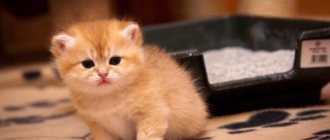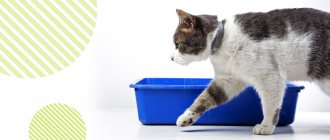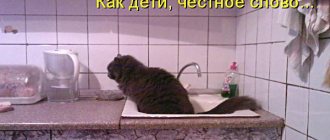Here are simple and working instructions that will help you quickly accustom your kitten to the litter box. Our guide will help you train your cat to go to the toilet in the right place in 3 days. Follow the recommendations and you will succeed. We also told you how you can train your cat to go to the toilet.
According to the table, select the correct filler. It should be environmentally friendly, not stain the kitten’s paws, not have a strong unpleasant odor, and should moderately retain odor.
| Type of filler | Block odor | Get your paws dirty | Harm to health | Has a smell |
| Silica gel | Fine | No | Dangerous if it enters the esophagus | No |
| Woody | Fine | No | No | Yes, a faint smell of pine |
| Clay | Fine | Dust gets wet and dirty | No | No |
| Mineral | Badly | Dust gets wet and dirty | No | No |
| Corn | Fine | small particles that can spread around the cat litter box | No | Yes |
| From paper waste | Badly | No | No | No |
Read our article with a detailed analysis of the choice of cat litter for the toilet.
Adaptation of a kitten to a new home
Many kitten sellers assure future breeders that the kitten is already accustomed to a tray and even a scratching post. This may be true, since many skills, habits and manners are instilled in their babies by a cat mother.
After a change in their usual environment, kittens, left without their mother, act according to circumstances and the useful skills they have already acquired may be lost. If the kitten is impatient, he will pee and pee in any place convenient for him, since he cannot yet fully control his natural urges.
It is useless to scold or punish a mustachioed pet. This will only embitter the kitten, and he will stop trusting you. The period of adaptation and socialization in the new home should take place with maximum comfort for the animal.
There are three types of trays for cats:
- With grill;
- Without bars.
- Closed type (toilet house).
In use, as practice shows, trays with bars are more convenient for many cats. Liquid feces pass through the grate and settle at the bottom. The paws and fur will remain clean after he has gone to the toilet in a small way.
In addition, many cats shit only because their paws get wet in the litter box during elimination. There are also individuals who do not like to go potty with any kind of litter, so also take this aspect into account.
When choosing where to place the tray, use the following tips:
- Place the pot in an accessible place. The cat must have constant access to its toilet.
- Do not place the urinal near heating or household appliances that make noise or loud sounds. The tray should not be placed near a battery, refrigerator, or washing machine.
- Do not place the tray in the aisle. Place it in a secluded, quiet place, for example, in a remote corner of the room, hallway, or bathroom.
Advice! Breeders recommend purchasing several trays at once and placing them in different places. Observe where the kitten likes to go the small way or the big way the most. Place the cat litter box there.
Where to begin?
Cats are naturally very clean. But a little kitten is just a child, and he gets lost in such simple things. If he lives with his mother, she will teach him to take care of himself, but a cat separated from his mother is helpless in this sense.
Age is very important: not every kitten can be quickly trained to use a litter tray. It is believed that if the animal is already a month old, the learning process will be fleeting. But experts argue with this statement. At this age, the cat is not yet very familiar with the structure of the world around him; he may not be ready to obey someone who demonstrates strength (in the good sense of the word). With a two-month-old kitten, the situation is easier: a new place and people do not scare him. With a three-month-old cat, as a rule, training goes quickly.
Training involves three actions:
- tray selection;
- choice of filler;
- choosing a permanent location for the cat litter box.
And only when all this is done can you introduce the little cat to the toilet. You cannot act from a position of cruelty. Some owners do just that: they think that excessive severity will immediately put everything in its place, and the cat will obey unconditionally. Give yourself and your pet three days, and until this “trial period” passes, don’t even think about scolding him or drawing premature conclusions.
Teaching a kitten to go to the same litter box as the cat
A grown-up kitten, studying the world around it, adopts and copies most of the habits from the cat and tries to imitate its mother. Some babies immediately begin to go to the same tray with the cat. But this does not mean at all that the cat teaches its offspring to relieve themselves on the tray. It's just that babies copy their mother's actions.
It is best to use a tray with litter, since cats go to the toilet based on the smell of their urine, and litters absorb unpleasant odors. If the toilet is without litter, keep it clean and wash it with water after each bowel movement.
But still, experts recommend purchasing a separate toilet for each animal. An adult cat, unless of course it is a mother cat, may not like the fact that another animal defecates in its litter tray.
Health problems
If a cat, accustomed to its litter box, suddenly begins to go to places undesirable for the owner, the cause may be diseases of the urinary or reproductive system. In this case, you don’t just need to stop your cat from pooping on the bed or other unwanted places, it’s important to pay attention to its health. Cystitis, inflammation of the uterus or ovaries, bladder stones and other diseases can cause the animal to become unclean. To fix a toilet problem, you need to treat the underlying condition. Exacerbation of inflammatory processes most often occurs during the cold season.
If puddles and heaps appear at the exit of the house or onto the balcony, they indicate the imminent onset of heat in a cat or the sexual desires of a young cat. This behavior can easily be eliminated by spaying, neutering or taking sedatives.
Another reason is more of a social nature. If the animal has a conflict with its owner or another pet has appeared in the house, problems with going to the toilet may also arise. Competition forces cats to divide their territory using marks, violating the toilet rules established by humans.
How to teach a kitten to go to the litter box at 1-2 months
In the first days, in order for the pet to quickly get used to the new environment, if you do not want to come across puddles and piles throughout the apartment, limit the pet’s movement. For example, close it in one room, in the hall or in the hallway. Place one or more trays there. Moreover, some may be with various fillers, others without. Take the animal to the tray. Let the cat sniff and explore a previously unfamiliar object.
On average, it will take about two to three weeks to train a one-month or two-month-old kitten to use a litter tray. The older the pet, the longer it will take.
Carefully observe the behavior of the fluffy. As a rule, kittens relieve themselves after sleep, some time after eating. Often a child will feel the urge to go to the toilet during or after active play.
To teach your cat to go to the litter box as quickly as possible, take the animal there as often as possible (after feeding, sleeping, during play). When the baby is in his potty, do not frighten or distract the pet until he has emptied.
The tray should not cause negative associations in the animal. As soon as the cat goes small or big, praise the pet and give a treat. Use treats only at the initial stage of litter box training.
If a kitten, after sitting on the tray, comes out of it and makes a puddle next to it, do not poke its muzzle into the feces and do not scold it.
Take a newspaper, napkins, soak them in urine, and put them in the tray, then take the cat there. Its own smell attracts and soon the pet will get used to the tray.
Does your kitten continue to ignore its litter box, despite all your efforts? Keep track of where it is emptied most often and move the tray there. Thoroughly wash all areas in the house where the cat has defecated. Use household chemicals or special aerosols with cat-repellent odors. Only by getting rid of cat marks can you achieve the desired result.
To the tray with fillers: sand, sawdust
It is difficult to teach one-month-old and even 2-2.5-month-old kittens, especially if you adopted an animal from the street, to pee and poop in a potty without litter. Nature dictates that cats bury their feces. Therefore, a potty tray without any loose substance to dig in with your paws will not attract your pet's interest. In addition, many cats refuse to go to a dirty litter box.
But you need to keep in mind that bulk mixtures from pet stores absorb the smell of feces. And as you know, cats follow their own “scent.” Therefore, in the first weeks, if you still plan to use fillers in the future, place a tray with sand or use soft sawdust.
Fillers for cat trays are:
- Mineral. The granules are made from bentonite and polygorskite rocks. They perfectly absorb the aromas of feces and quickly absorb moisture.
- Woody. They are sawdust from various types of wood. They require frequent replacement, but are suitable for both kittens and adult animals.
- Corn. An environmentally friendly option for fillers. They have a specific aroma that the kitten may not like; they do not absorb unpleasant odors well.
- Silica gel. They have excellent absorbent properties and absorb unpleasant odors.
Experts recommend using special fine-grained soft fillers for kittens that do not dig into the pet’s pads and do not cause discomfort.
For kittens, it is best to use soft wood sawdust. Make sure that the filler does not have sharp pieces of wood. The kitten may injure the pads and refuse to go to the litter box. In order not to cause allergies in the furry, we do not recommend using pellets made from coniferous wood.
The disadvantage of wood filler is that when it absorbs moisture, it disintegrates and does not gather into separate lumps. Therefore, it is best to use pellets in trays with grates. The disintegrated sawdust will settle on the pallet and can be easily removed from there.
Tray with grid without filler
Many breeders immediately plan to accustom the kitten to litter trays without any fillers. A kitten up to two months old may not like an empty tray. Therefore, at the initial stage of training, in order to achieve faster results, it is still better to use a small amount of filler. Sand can be replaced with newspaper and napkins. The main thing is that the kitten can bury its feces.
To teach your cat to go to a tray without filler, or to a tray with a grid, constantly monitor its cleanliness. After each emptying, rinse it thoroughly with running water. There should be no salt deposits on the pallet. Do not use strongly scented household chemicals. The pungent smell will scare away the cat, and the pet will choose a more attractive place to fulfill its natural needs.
Which filler to choose
The choice of filler is the personal preference of the owner. Home remedies you can use are sand, scraps of paper, and sawdust. However, animals carry sand and sawdust on their paws throughout the apartment, and the paper quickly gets wet.
Industrial options are divided into clumping and absorbent. It is believed that clumping fillers are more convenient. They are made from various materials. The granules absorb urine and form a lump that is easy to remove with a scoop.
For small pets, you can only lightly cover the bottom with granules; you don’t need to pour a lot. The same as for an adult animal, which, vigorously burying, scatters everything on the floor. It's better to change the content more often.
What to do if the kitten does not go to the litter tray for the most part?
If the kitten pees on the litter box but doesn't go there much, the problem may be that the litter box is not, in the cat's opinion, where it is comfortable for her. Some cats refuse to poop in the toilet unless there is litter in it.
To solve the problem, place another tray where you most often find piles. Pour some litter in there if the kitten refuses to poop in a tray without any loose substance. Take your pet to the litter box and praise him after defecation.
If the cat, after all his efforts, ignores the tray and does not go there for long, perhaps the pet simply does not reach it or the animal has health problems.
Note that some cats go to the toilet in a small way in the tray, and in a big way near the tray. This is a genetically and historically formed habit that is almost impossible to wean off. Therefore, humble yourself and do not scold your pet again.
Teaching your pet to leave the apartment on his own
It is possible to teach a cat living in an apartment to go outside on his own, but it is not always recommended. This is especially true in cases where stray dogs may be walking in the yard. Cats may not leave the apartment in a number of cases:
- strong fear (dangers waiting on the street);
- fear of not returning home.
Having decided to teach your cat to walk outside on his own, leaving the apartment, you need to be patient and act gradually. To begin with, you need to pick up the cat and take him out for no more than 5-10 minutes. Then the time is increased, and when the cat gets used to it, you can start learning to walk on a leash.
You need to pick up a special harness at a pet store and take your first walks in an apartment. Veterinary experts do not recommend leaving your pet unattended for a long time, and also not walking it without a harness. On the street, a cat may be frightened by a dog (at best) or by a sharp sound.
How to litter train an outdoor kitten
The process of accustoming an outdoor kitten to a litter box may take longer, since the animal is used to relieving itself wherever it wants or likes it. The older the kitten, the longer it will take to teach him the right skills.
For the first week, limit the kitten's movement around the apartment. Place several trays in different places in its habitat. Use wood or any other filler. An outdoor kitten will not go to the litter box without a loose substance that can be buried in with its paws. Therefore, add any filler so that the kitten does not feel the difference. Most willingly, street kittens go to a tray with sand.
Take the kitten to the litter box for familiarization. Do not hit or scold the fluffy if he shits in the wrong place. Blot up the puddle left by the animal on the floor with a napkin and place it in the tray. Praise the kitten as soon as he goes potty. Give me a treat.
If in the future you plan to use a tray with a mesh and without fillers, as soon as the cat learns to do things in the right place, gradually reduce the amount of filler.










